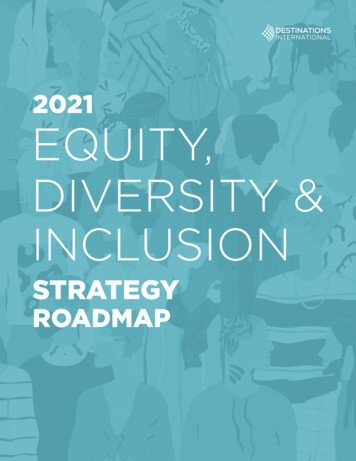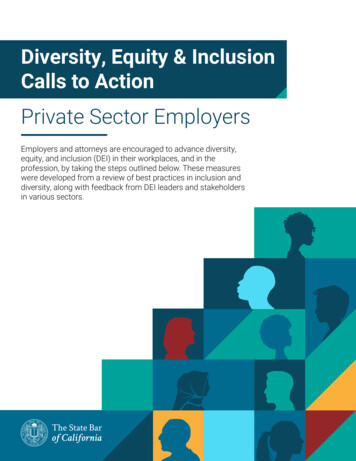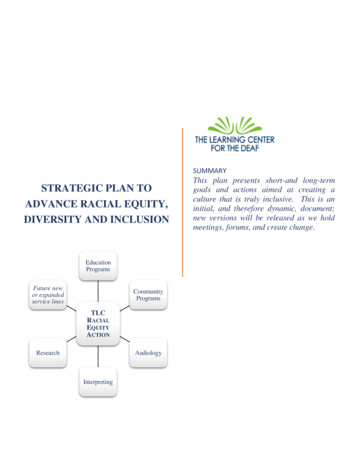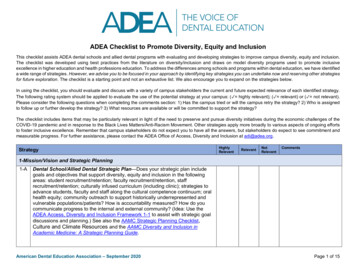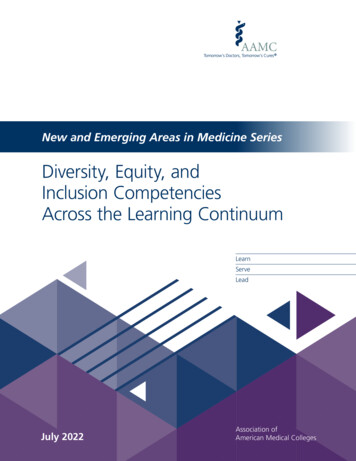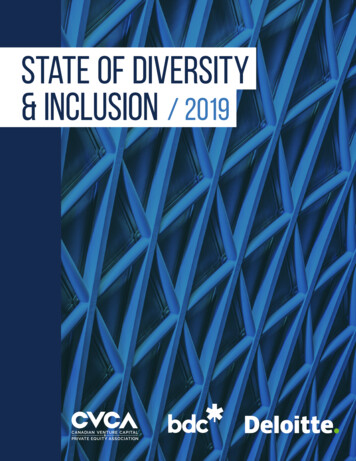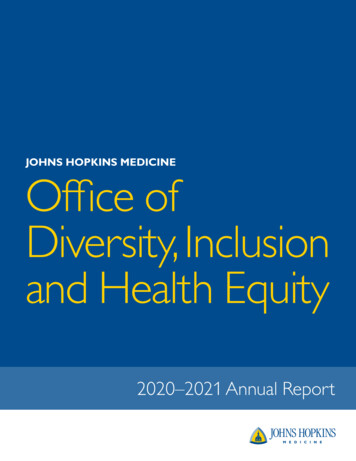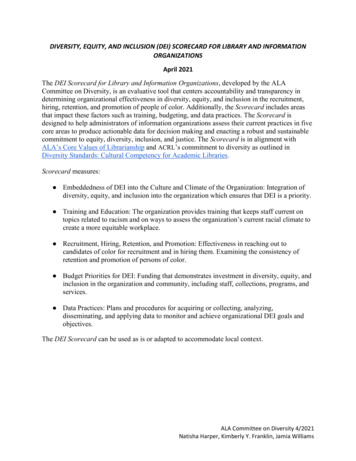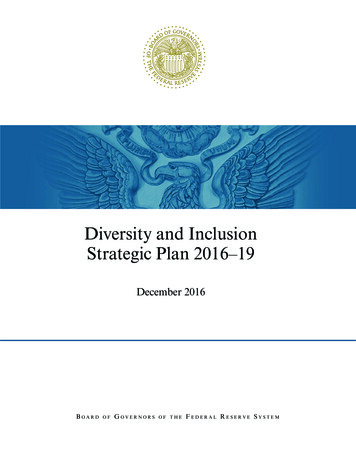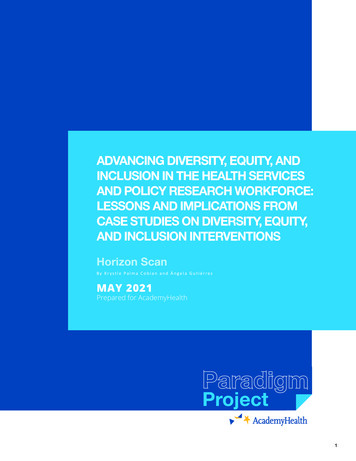
Transcription
ADVANCING DIVERSITY, EQUITY, ANDINCLUSION IN THE HEALTH SERVICESAND POLICY RESEARCH WORKFORCE:LESSONS AND IMPLICATIONS FROMCASE STUDIES ON DIVERSITY, EQUITY,AND INCLUSION INTERVENTIONSHorizon ScanBy Krystle Palma Cobian and Ángela GutiérrezMAY 2021Prepared for AcademyHealth1
ABOUT THIS HORIZON SCANThis report provides an overview of existingdiversity, equity, and inclusion (DEI) programsand practices to ultimately stimulateconversations and action that can advanceDEI within health services and policy research(HSR). In this report, we present four caseshighlighting DEI program interventions orpractices within academia and the scientificworkforce: career development/trainingprograms, cluster hiring, career mentorship,and community-based participatory research.Each case summary provides an overviewof the program or approach, outcomes,lessons applicable to HSR, and implicationsto consider as HSR continues to advanceits capacity to address structural barriers toachieving workforce equity.2ABOUT THE PARADIGMPROJECTThe Paradigm Project is a concerted, collaborative effort to increase the relevance, timeliness, quality, andimpact of health services research (HSR). Convenedby AcademyHealth and funded by the Robert WoodJohnson Foundation, the project is ideating and testing new ways to ensure HSR realizes its full potentialto improve health and the delivery of health care. TheParadigm Project is designed to push HSR out of itscomfort zone—to ask what works now, what doesn’t,and what might work in the future.Learn more atwww.academyhealth.org/ParadigmProject.
EXECUTIVE SUMMARYIndividuals from historically marginalized groups in theUnited States are disproportionately underrepresented andunderserved at all levels of the scientific workforce (NationalScience Foundation, 2019), including the multi-disciplinary,multisectoral field of health services and policy research(Frogner, 2018). As part of an overall commitment to theadvancement of equitable health and well-being, the need toaddress DEI within the health services and policy researchworkforce is critical (Edmunds et al., 2015). The diversebackgrounds and lived experiences of professionals within theHSR workforce foster scientific innovation and robust learningenvironments, improve the quality of research, enhance ourglobal competitiveness, and advance equitable health andcareer outcomes among underserved populations. (NationalInstitutes of Health, 2019). Yet, strategies to achieve DEI inthe HSR workforce often fall short, and at times may continueto reproduce or exacerbate disparities with respect to fullparticipation in HSR.The purpose of this report is to examine practices that haveresulted in improvements in workforce diversity in academiaand the scientific workforce. We highlight innovative science,technology, engineering, and mathematics (STEM) interventionprograms and strategies that are well-funded or well-knownfor their success in improving the recruitment, retention, andadvancement of underrepresented groups (URG). The first casedraws on the National Cancer Institute’s (NCI) CURE Programto highlight diversity and inclusion efforts within academicmedicine, and to provide tangible lessons for recruitment andretention across educational and academic career stages.The second case draws on the growing practice of clusterhiring in recruiting and retaining scientific diversity withinacademia. The third case draws on mentoring programs tounderscore the importance of mentorship for early- and midcareer researchers. The fourth case highlights the value ofcommunity partnerships for improving the rigor of work andreach of health services and policy researchers. We discusskey lessons that may be transferable and/or adapted to thefield of HSR. We provide recommendations and underscore theneed to acknowledge and address systemic barriers that URGsencounter along the HSR career pathways.ACRONYMSCBPR community-basedparticipatory researchDEI diversity, equity, and inclusionESI early-stage investigatorHSR health services and policyresearchMSI minority-serving institutionNCI National Cancer InstituteNIH National Institutes of HealthNSF National Science FoundationSTEM science, technology,engineering, and mathematicsURGs underrepresented groupsWRGs well-represented groups3
ENHANCING DEI IN CANCER RESEARCH:THE CURE TRAINING PROGRAMThe NCI-funded Umbrella of Research Experiences (CURE) program aims to diversify thebiomedical sciences and cancer health disparities workforce by providing educational, careerdevelopment, and funding opportunities across the continuum from middle school to juniorinvestigator (National Cancer Institute, 2020). The distinct funding, training, and mentoringsupports across the educational and career pathway promote competitiveness among studentsand enhance the recruitment and retention of the health-focused workforce. Since its inception,the CURE program has awarded an estimated 5,000 grants, reaching nearly 2,600 studentsand early-career researchers (Center to Reduce Cancer Health Disparities, 2011). The impactand productivity of the CURE program has grown exponentially, such that, in 2010, CUREtrainees had authored 175 peer-reviewed publications, relative to 25 publications in 2006(Center to Reduce Cancer Health Disparities, 2011). Across all career stages, CURE scholarshave authored over 1,700 peer-reviewed publications. The strong commitment to workforcediversity among high-profile leaders and federal agencies, coupled with the use of a life-courseapproach contributed to the success of the CURE program.Lesson: Although the CURE program is a highly-regarded NCI program, it is important to notethat individual-level programs alone are not sufficient to address workforce diversity issues.To address workforce diversity challenges, a multi-pronged approach must be implemented.Although individual-level training programs are useful in moving the needle, recognizing andaddressing the social structures and institutional cultures that produce and reproduce thesepersistent inequities are necessary to advance DEI.CLUSTER HIRING: FOREGROUNDING DEI TO ATTRACT &SUPPORT A DIVERSE AND ACADEMICALLY EXCEPTIONALCANDIDATE POOLCluster hiring has the potential to increase the likelihood of retention, enhance socialization,and minimize feelings of isolation among faculty hires from URGs. We review the cluster hireexperience at the College of Arts and Sciences at Emory University. From 2014 – 2017, theCollege of Arts and Sciences hired 65 tenure-track faculty members; 85% of the hires werefrom well-represented groups (WRGs), whereas only 15% were from URGs (Freeman, 2019).These disparities led to the College of Arts and Sciences at Emory University to turn to clusterhiring as a way to increase diversity among their faculty. The search committee foregroundeda commitment to minority students by requiring all candidates to write a statement about theirexperiences with and vision for diversity, and to discuss how candidates foster diversity andmentor diverse populations (Freeman, 2019). Candidates with strong mentoring statementswere selected for the next stage of review, which assessed research excellence using traditionalindicators, such as publications, scholarly independence, and grant funding (Freeman, 2019).After these modifications to the faculty search, the College of Arts and Sciences hired 80tenure-track faculty members, with 51% of new hires from URGs during 2017 – 2019 (Freeman,2019).Lesson: While cluster hiring may achieve many DEI goals, several systemic issues should alsobe considered in order to avoid reifying inequities in faculty hiring and retention.4
THE POWER OF PINPOINTING MENTORSHIP TOSUPPORT RESEARCH CAREER ADVANCEMENTThe National Research Mentoring Network (NRMN) provides trainees across the biomedical,behavioral, clinical, and social sciences with evidence-based mentorship and professionaldevelopment (Sorkness et al., 2017, p. 172). The NRMN piloted four coaching programs.The pilot programs have shown a significant improvement in participants’ grant writing selfefficacy (Thorpe et al., 2020), significantly accelerating participants’ average time to grantproposal submission by 148.6 days (Hall et al., 2018). The programs are also starting to expandnationwide, such that the NRMN introduced five new locations to host one of the grant writingprograms, scaling impact to reach new participants and faculty coaches. Several lessons fromthe NRMN programs in particular and mentoring more broadly can inform mentoring withinHSR. First, leaders in HSR can allocate resources and support for comprehensive mentoringprograms for early- and mid-career HSR researchers. Second, as mentorship for early-careerand mid-career professionals should not be limited to grant writing support alone, leaderswithin HSR can conduct research to pinpoint additional areas where and for whom disparitiesexist along the HSR career paths. Third, leaders can advocate for federal agencies to directfunds toward advancement of historically marginalized groups in HSR.Lesson: While this case focused primarily on the NRMN grant writing program, we expand uponlessons from this case to the larger practice of mentorship initiatives for early- and mid-careerscholars who may work in a broad range of settings. As the HSR sector encompasses thosewho work in corporate, policy centers, and governmental agencies as well, there is a need todevelop several mentorship opportunities that highlight the various viable career options withinHSR. This inclusivity can work to retain early- and mid-career professionals within HSR.THE PROMISE OF COMMUNITY-BASED PARTICIPATORYRESEARCH AND COMMUNITY PARTNERSHIPS FORADVANCING DEI IN HSRThe HSR field has increasingly conducted research where the data are (e.g., hospitals,universities, integrated primary care), focusing on hospital claims data and electronic healthrecords data (Whicher et al, 2018). As such, the National Academy of Medicine urges the HSRworkforce to move research into communities, in an effort to bridge health and social servicesto improve access to care (Whicher et al, 2018). Fostering partnerships with communitypartners can minimize persistent health disparities, improve the quality of research, andadvance DEI within the HSR workforce. This case study focuses on the methodologicalapproach of community-based participatory research (CBPR) and the partnership betweenacademic researchers and promotoras to produce rigorous community-based research.Promotoras are lay health workers; they are under the community health worker umbrella(Centers for Control and Disease Prevention, 2019). CBPR is an orientation that emphasizesequitable engagement of partners throughout the research process, builds on strengths andresources within the community, fosters a collaborative, equitable partnership throughoutall phases of research, and fosters an empowering and power-sharing process to respondto social inequalities (Minkler, Garcia, Rubin, & Wallerstein, 2012; Cacari-Stone, Wallerstein,Garcia, & Minkler, 2014). Corazón y Carácter, a promotora organization, partnered withacademic researchers to co-lead a qualitative research study on the workforce experiences of5
promotoras. They presented their work at local settings and national conferences (Marquez etal., 2019) and published their findings to extend the scientific literature (Gutierrez et al, 2020).Applying a CBPR approach yielded several benefits: high quality research that was informed bycommunity members’ and scientific priorities, fostering equitable and horizontal partnerships,and fostering career development for both academic and community partners.Lesson: Partnering with community organizations and community partners, such aspromotoras, can ultimately enhance scientific rigor. Moreover, partnering with promotoras canenhance recruitment science, which can mitigate the documented challenges in recruitment andretention of participants in HSR studies (Asch, Connor, Hamilton, & Fax, 2000).RECOMMENDATIONS1. Implement multi-pronged approaches targeting the individual, community, state, andfederal levels. This is essential to shift the culture of the HSR workforce. Multi-prongedapproaches should continue to focus on individual and local level efforts, but shouldalso address structural barriers in workforce diversity. Multi-pronged approachesmust also recognize the crucial role of leadership in advancing DEI.2. Implement long-term and targeted approaches to advance DEI within distinct levelsof an organization (e.g., entry-level, intermediate level, and leadership positions).For instance, targeting approaches can involve: (1) promoting and advancing awelcoming climate that supports DEI; (2) addressing negative climate by mitigatinghostility and discrimination grounded in race, sex, or other federally protectedcharacteristics; (3) promoting research that informs and addresses the breadth ofinequities in HSR; and (4) reassessing who is able to participate in knowledgeproduction within HSR.3. Increase exposure to the multidisciplinary field of HSR early on. To introducepotential talented researchers to the field of HSR, programs aimed to recruit andretain potential HSR professionals must consider training, mentoring, and supportas early as middle-school and high school. Financial support, training andmentorship must be catered to various stages along an HSR career path.4. Track progress toward DEI goals through investing in continuous data collectionand assessment of efforts. Track and analyze data on intersectional identities andmultiple markers of identities that may also be underserved locally.6
1. INTRODUCTIONIndividuals from historically marginalized groups are disproportionately underrepresentedand underserved at all levels of the scientific workforce (National Science Foundation, 2019),including the multi-disciplinary, multisectoral field of health services and policy research (HSR)(Frogner, 2018). As part of an overall commitment to the advancement of equitable health andwell-being, the need to address DEI within the HSR workforce is critical (Edmunds et al., 2015).The diverse backgrounds and lived experiences of professionals within the HSR workforcefoster scientific innovation and robust learning environments, improve the quality of research,enhance our global competitiveness, and advance equitable health and career outcomes amongunderserved populations. (National Institutes of Health, 2019). AcademyHealth recognizes thesystemic, institutional, and historical factors that work against diversity and equity in HSR andthe larger HSR workforce (Edmunds et al., 2015) and is committed to actively promoting bestpractices to increase the participation of underrepresented groups (URG) in the field of HSR.Yet, strategies to achieve DEI in the HSR workforce often fall short, and at times may continueto reproduce or exacerbate workforce disparities for URGs.The COVID-19 pandemic and the increased attention to racist police violence sparked by themurders of Black victims George Floyd and Breonna Taylor further highlight the significantimpacts of racism on population-level morbidity and mortality disparities (Benjamin, 2020).These events in 2020 sparked several national health and federal science organizations (e.g.,the American Medical Association, American Public Health Association, National Institutes ofHealth, National Science Foundation), to explicitly name plans to address structural racism andracial inequity (American Medical Association, 2020; American Public Health Association, 2020;Collins, 2021; National Science Foundation, 2020). These calls underscore the urgent need toacknowledge and address structural inequities in health care and science. Moreover, as HSRis a multidisciplinary field, advancing DEI within HSR will require an understanding of (1) thehistorical and current social context of exclusionary practices within the field and (2) the uniquehistories of structural inequity within each sector that comprises HSR. Simply put, advancingDEI efforts in the HSR workforce will require a continuous and critical reassessment of DEIprograms, practices, and policies to account for, and address the differential opportunities toaccess and advancement in the field.The purpose of this report is to re-examine practices that have resulted in measurable DEIprogress in academia and the scientific workforce. Since strategies for increasing DEI withinHSR likely overlap with effective approaches already being implemented in academia and thescientific workforce more broadly, successful efforts to combat systemic barriers in science,technology, engineering, and mathematics (STEM) fields can provide key lessons to consider.We highlight innovative strategies that have been successful in improving the recruitment,retention, and advancement of groups who are underrepresented in HSR, and reflect on howthese well-known models and practices can be improved when considering structural inequity.In this report, we provide an overview of four cases that have been well-funded or well-knownamong STEM intervention programs. These cases provide lessons to measurably enhance DEI.The first case draws on the National Cancer Institute’s (NCI) CURE Program to highlight DEIefforts within academic medicine, and to provide tangible lessons for recruitment and retentionacross educational and academic career stages. The second case draws on the growing7
practice of cluster hiring in recruiting and retaining scientific diversity within academia. Thethird case draws on mentoring programs to underscore the importance of mentorship for earlyand mid-career researchers. The fourth case highlights the value of community partnerships forimproving the rigor of work and reach of health services and policy researchers.For each case, we call attention to innovative strategies that have shown promise in improvingthe recruitment, retention, and advancement of underrepresented groups within that sector.We also consider the limitations associated with the strategies and approaches implemented.Underscoring these strategies is an overarching recommendation that practices mustacknowledge and specifically address systemic barriers that URGs encounter along the HSRcareer pathways. Since the HSR workforce is not solely employed in academia, we expandupon lessons and nuanced considerations to encompass a broad range of sectors.2. ENHANCING DEI IN CANCER RESEARCH:THE CURE TRAINING PROGRAMHealth disparities research has well-documented a disproportionately high burden of disease,including high rates of cancer, among racial and ethnic minorities (Smith et al., 2009).Moreover, racial and ethnic minorities, women, individuals with disabilities, and individuals fromdisadvantaged backgrounds (e.g., low-income first-generation students) are underrepresentedin the biomedical, clinical, behavioral, and social sciences workforce (National Institutes ofHealth, 2020). The lack of diversity in the health workforce translates to inequitable accessto care and to medical advances through diverse mechanisms, such as implicit racial/ethnicbias among health care providers (Maina, Belton, Ginzberg, Singh, & Johnson, 2018), medicalmistrust and low satisfaction with health care services (Lopez-Cevallos, 2014), and limitedgeneralizability of findings (Salman, Nguyen, Lee, & Cooksey-James, 2016).Dr. Francis Collins, director of the NIH, underscored the need to reduce health disparities bystating, “If we don’t include as part of this agenda a very major focus on health disparities,we [will] have failed at one of our most important missions at NIH—a problem that has to beunderstood and ultimately solved” (Center to Reduce Cancer Health Disparities, 2011). Asthe NCI is committed to increasing equity in the medical advances identified through cancerresearch (Center to Reduce Cancer Health Disparities, 2011), the NCI houses the ContinuingUmbrella of Research Experiences (CURE) program. The CURE program aims to diversify thebiomedical sciences and cancer health disparities workforce by providing educational, careerdevelopment, and funding opportunities across the continuum from middle school to juniorinvestigator (National Cancer Institute, 2020). Consequently, we review the CURE program as acase study for training throughout the educational and career pathway.Distinct training, mentoring, and funding mechanisms are geared toward targeted educationaland career stages. For instance, research education programs (R25s) are geared towardsmiddle school, high school, and undergraduate students. Diversity research supplements (PA20-022) and National Research Service Awards (NRSA, F31) are geared towards pre-doctoralgraduate students. Diversity research supplements (PA-20-022), mentored career developmentawards (K01and K08), and re-entry research supplements are geared towards postdoctoralearly stage investigators. Diversity research supplements (PA-20-022), mentored careerdevelopment awards (K01, K08), non-mentored career development awards (K22), exploratorygrant awards (R21), and re-entry research supplements (PA-18-592) are geared towards8
investigators. The distinct funding, training, and mentoring supports across the educational andcareer pathway promote competitiveness among students and enhance the recruitment andretention of the health-focused workforce.Since its inception, the CURE program has awarded an estimated 5,000 grants, reaching nearly2,600 students and early-career researchers (Center to Reduce Cancer Health Disparities,2011). The impact and productivity of the CURE program has grown exponentially. Forinstance, in 2010, CURE trainees had authored 175 peer-reviewed publications, relative to25 publications in 2006 (Center to Reduce Cancer Health Disparities, 2011). Across all careerstages, CURE scholars have authored over 1,700 peer-reviewed publications and 27% ofCURE scholars engage in cancer health disparities research (Center to Reduce Cancer HealthDisparities, n.d.). As of 2011, 27 CURE trainees became assistant professors, 11 associateprofessors, four full professors, one professor of surgery, and one senior vice president forclinical research (Franco et al., 2011). Collectively, these data suggest that CURE traineesare scientifically productive and are steadily advancing in their career stages. Nevertheless,publicly available evaluations of the CURE program are dated and more recent evaluations areneeded to fully assess whether the CURE program continues to have a positive impact on thepublication productivity and career progression of its trainees.The CURE program’s success has resulted in other institutions implementing similar programs.For instance, Northwestern University’s Feinberg School of Medicine used the CURE programas a model for the Students Engaged in Elder Research (SEER) project (Center to ReduceCancer Health Disparities, 2011).LESSONS FOR THE HSR SECTORSeveral factors contributed to the success of the CURE program. First, the strong commitmentto workforce diversity among high-profile leaders (e.g., Dr. Francis Collins) and federal agencies(e.g., National Cancer Institute) resulted in the allocation of resources for the various fundingmechanisms and programs that support the CURE program. Buy-in from organizationalleaders can have tremendous implications for the allocation of resources to promote workforcediversity.Second, the CURE program used a life-course approach (Elder, Johnson, & Crosnoe, 2003),where CURE scholars were mentored and supported across a range of educational andprofessional stages in their career trajectory. The CURE program tailored mentoring, training,and funding based on career stage, which ultimately fostered recruitment, retention, andcareer progression among trainees. By starting at the early stages of education (e.g., middleschool) and providing support up to early-stage investigator status, the CURE program wasable to provide training, funding, and mentorship during critical career junctures that requiretraining and acumen to navigate. While not all training programs have the resources to employa life-course approach to developing talented researchers, a modified life-course approachmight focus on specific training and small grants for graduate students, postdoctoral scholars,researchers entering their first year as full-time scholars and/or faculty, and early careerresearchers who may be considering options for their next career step.Third, the CURE program, along with other local, state, and federal programs, can identifybest practices by routinely conducting program evaluations. Ultimately, program evaluationscan identify which facets of the program (e.g., mentoring, grant writing, and funding) have thelargest impact on scientific productivity and career progression.9
Although the CURE program is a highly-regarded NCI program, it is important to note thatindividual-level programs alone are not sufficient to address workforce diversity issues.Although individual-level training programs are useful in moving the needle, recognizing andaddressing the social structures and institutional cultures that produce and reproduce thesepersistent inequities are necessary to advance DEI. For instance, scholars have identifiedsocioeconomic status (SES) and racism as fundamental causes of health disparities (Phelan,Link, & Tehranifar, 2010; Phelan & Link, 2015). Recent research suggests early-life SES alsoshapes workforce inequities. A survey among 7,218 professors across eight disciplines in PhDgranting departments across the U.S. found that nearly one-quarter of faculty have at least oneparent who holds a PhD and that faculty at elite departments are 54% more likely to have aPhD-holding parent than faculty at less prestigious institutions (Morgan, LaBerge, Larremore,Galesic & Clauset, 2021). Collectively, these findings underscore the need to address structural,intergenerational, and intersectional factors producing and reproducing workforce inequities.Lessons from the NCI CURE Program to Promote DEI in the HSR Workforce: Commitment to enhancing DEI among institutional leaders Employ a life course approach to training programs in order to provide tailoredmentoring, training, and support based on trainees’ career stages Routinely conduct program evaluations to identify which components of theprogram have the largest impact on career progression3. CLUSTER HIRING: FOREGROUNDING DEI TO ATTRACT &SUPPORT A DIVERSE AND ACADEMICALLY EXCEPTIONALCANDIDATE POOLCluster hiring is an important initiative to investigate due to its potential to address racialand gender gaps in faculty hiring and retention. While empirical evidence regarding variousoutcomes associated with cluster hiring are still being explored, several studies suggest thathow cluster hiring is utilized can make a difference in creating a climate where newly-hiredfaculty can be successful while also diversifying the professoriate. One campus that reportedsuccessful outcomes is the College of Arts and Sciences at Emory University. From 2014 –2017, the College of Arts and Sciences hired 65 tenure-track faculty members; 85% of the hireswere from well-represented groups (WRGs), whereas only 15% were from underrepresentedgroups URGs (Freeman, 2019). These disparities led to the College of Arts and Sciences atEmory University to turn to cluster hiring as a way to increase DEI among their faculty.The cluster hire experiment consisted of an open-rank, open-field search across eight STEMunits in the college of Arts and Sciences and involved over 30 faculty members from variousdepartmental search committees (Freeman, 2019). The search committee foregrounded acommitment to minority students by requiring all candidates to write a statement about theirexperiences with and vision for diversity, and how candidates foster diversity and mentordiverse populations (Freeman, 2019). Candidates with strong mentoring statements wereselected for the next stage of review, which assessed research excellence using traditional10
indicators (e.g., publications, scholarly independence, and grant funding) (Freeman, 2019). Afterthe changes, the College of Arts and Sciences hired 80 tenure-track faculty members, with 51%of new hires (n 41) from URGs during 2017 – 2019 (Freeman, 2019).The success Emory experienced and the growing attention to cluster hiring (Bhalla, 2019;Flaherty, 2017; Sgoutas-Emch, Baird, Myers, Camacho, & Lord, 2016) resulted in NIH approvingthe Faculty Institutional Recruitment for Sustainable Transformation program, which is a 9-year, 241 million initiative that provides funding to institutions that pledge to hire ten or more earlycareer faculty members within a two-year period (Mervis, 2020).LESSONS FOR THE HSR SECTORThe College of Arts and Sciences at Emory University serves as a case study that was able toattract a diverse and academically exceptional pool of candidates. First, Emory foregroundeda commitment to DEI and talent development through prioritizing candidates’ mentoringstatements in the selection process. Even when intentional planning and resources cannot beallocated to a cluster hire, faculty hiring committees can change their faculty hiring process to,at minimum, prioritize a faculty candidate’s knowledge, skills, and potential to be inclusive andequity-minded in their approach to teaching and mentoring students.Second, Emory’s success with cluster hiring was largely shaped by the involvement of seniorleaders (e.g., senior associate dean of the college of arts and sciences) and collaborations withover 30 faculty members from diverse departments. The senior associate dean of faculty atEmory University’s College of Arts and Sciences underscores the fact that successful clusterhiring necessitates a combination of purposeful outreach, cross-campus collaboration, andfunding (Freeman, 2019). Cluster hiring is an enormous undertaking that necessitates manyresources,
and productivity of the CURE program has grown exponentially, such that, in 2010, CURE trainees had authored 175 peer-reviewed publications, relative to 25 publications in 2006 (Center to Reduce Cancer Health Disparities, 2011). Across all career stages, CURE scholars have authored over 1,700 peer-reviewed publications.

